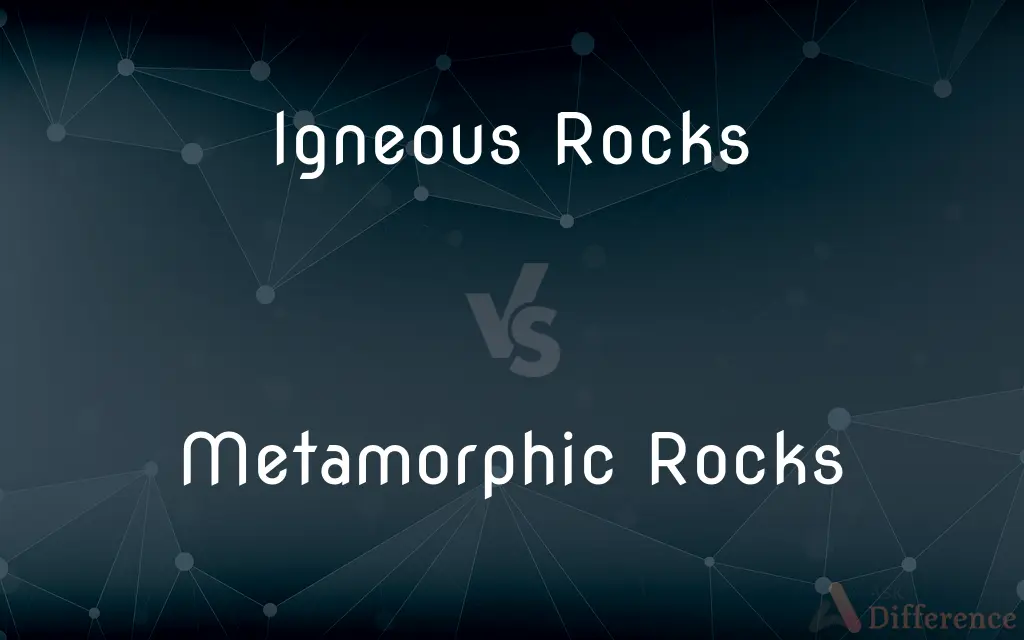Igneous Rocks vs. Metamorphic Rocks — What's the Difference?
By Tayyaba Rehman — Published on January 29, 2024
Igneous rocks form from cooled magma or lava, while metamorphic rocks originate from existing rocks transformed by heat and pressure.

Difference Between Igneous Rocks and Metamorphic Rocks
Table of Contents
ADVERTISEMENT
Key Differences
Igneous rocks are formed from the solidification of magma or lava. This process can occur either beneath the earth's surface, resulting in intrusive igneous rocks like granite, or on the surface as extrusive igneous rocks like basalt. Metamorphic rocks, in contrast, are formed from existing rocks (which can be igneous, sedimentary, or other metamorphic rocks) that undergo a transformation due to intense heat, pressure, or chemical processes, leading to a substantial change in their mineral composition and texture.
The texture and composition of igneous rocks are determined by the rate at which the magma or lava cools and solidifies. Slow cooling leads to larger crystals, while rapid cooling results in a fine-grained texture. Metamorphic rocks, however, develop new textures and structures, such as foliation or banding, as a result of the metamorphic process. This process can also lead to the formation of new minerals not originally present in the parent rock.
Igneous rocks are typically hard and dense and can be either coarse-grained (like granite) or fine-grained (like basalt). Metamorphic rocks can vary widely in hardness and texture, from slate, which splits easily along foliation lines, to marble, which is hard and often used in sculpture and construction.
In terms of geographical distribution, igneous rocks are commonly found in volcanic regions and areas with historical volcanic activity. Metamorphic rocks are typically found in regions that have been subjected to tectonic forces, such as mountain ranges where rocks have been deeply buried or deformed by the earth's crustal movements.
Both igneous and metamorphic rocks are important for understanding the earth's geology. Igneous rocks provide insights into volcanic processes and the composition of the earth's interior, while metamorphic rocks reveal information about the geological history of an area, particularly the conditions that existed deep within the earth's crust.
ADVERTISEMENT
Comparison Chart
Formation Process
Solidification of magma or lava
Transformation of existing rocks by heat and pressure
Texture and Composition
Determined by cooling rate of magma/lava
Formed by pressure and heat, resulting in new textures
Typical Features
Hard and dense, can be coarse or fine-grained
Varies widely, may have foliation or banding
Common Locations
Volcanic regions and areas with past volcanic activity
Regions with significant tectonic activity
Geological Significance
Provide insights into volcanic processes and earth's interior
Reveal geological history and crustal conditions
Compare with Definitions
Igneous Rocks
Formed from cooled magma or lava.
Granite is an igneous rock commonly used in construction.
Metamorphic Rocks
Formed from existing rocks under heat and pressure.
Marble is a metamorphic rock that originated as limestone.
Igneous Rocks
Often has a crystalline texture.
The large crystals in this igneous rock indicate slow cooling.
Metamorphic Rocks
Indicates geological history and conditions.
The study of metamorphic rocks helps us understand Earth's past.
Igneous Rocks
Varied textures based on cooling rate.
Obsidian, a glassy igneous rock, forms from rapid cooling.
Metamorphic Rocks
Found in regions with tectonic activity.
This mountain range contains numerous metamorphic rocks.
Igneous Rocks
Indicates past volcanic activity.
The presence of igneous rocks here suggests historical volcanism.
Metamorphic Rocks
Exhibits new textures and structures.
The foliation in this metamorphic rock is due to intense pressure.
Igneous Rocks
Can be intrusive or extrusive.
Basalt is an extrusive igneous rock that forms from lava.
Metamorphic Rocks
Can be hard and used in construction.
Slate, a metamorphic rock, is used for roofing materials.
Common Curiosities
What causes the formation of igneous rocks?
The cooling and solidification of magma or lava.
How are metamorphic rocks formed?
From the transformation of existing rocks by heat and pressure.
Can metamorphic rocks originate from sedimentary rocks?
Yes, sedimentary rocks can transform into metamorphic rocks.
Do metamorphic rocks always have foliation?
Not always, but foliation is a common feature in many metamorphic rocks.
What are examples of igneous rocks?
Granite and basalt.
What textures do igneous rocks have?
They can be coarse-grained like granite or fine-grained like basalt.
Are igneous rocks used in construction?
Yes, especially granite due to its durability.
Can igneous rocks form underground?
Yes, as intrusive rocks like granite.
Are all metamorphic rocks hard?
Many are hard, but their hardness can vary.
Do igneous rocks contain fossils?
No, fossils are not typically found in igneous rocks.
Where are igneous rocks typically found?
In and around volcanic regions.
What kind of pressure forms metamorphic rocks?
Intense pressure often from tectonic forces.
What information do metamorphic rocks provide?
Insights into past geological conditions and processes.
How do geologists study igneous and metamorphic rocks?
By analyzing their mineral composition, texture, and formation processes.
What are examples of metamorphic rocks?
Marble and slate.
Share Your Discovery

Previous Comparison
Cayenne Pepper vs. Paprika
Next Comparison
Scribes vs. PhariseesAuthor Spotlight
Written by
Tayyaba RehmanTayyaba Rehman is a distinguished writer, currently serving as a primary contributor to askdifference.com. As a researcher in semantics and etymology, Tayyaba's passion for the complexity of languages and their distinctions has found a perfect home on the platform. Tayyaba delves into the intricacies of language, distinguishing between commonly confused words and phrases, thereby providing clarity for readers worldwide.













































